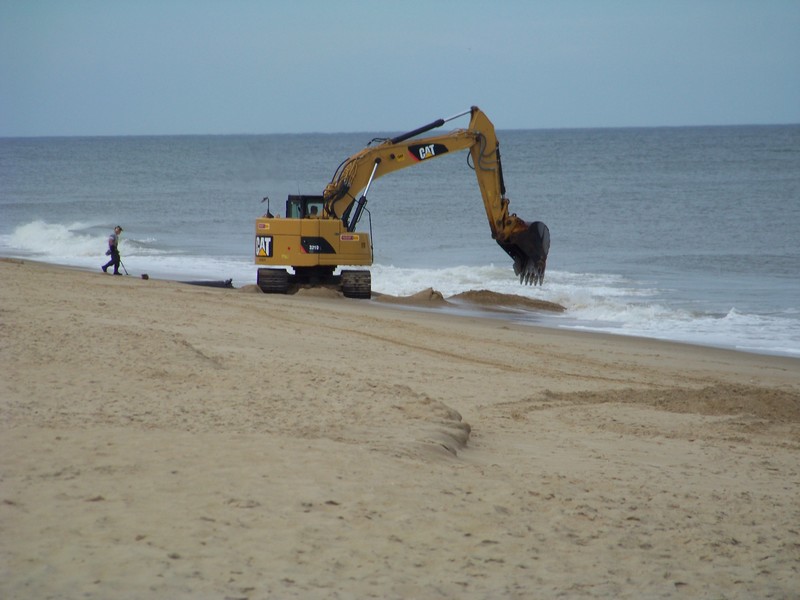Rehoboth pipe extension to cost city $200,000

Rehoboth Beach officials unanimously approved spending $200,000 in city funds to extend the stormwater outfall pipe at Rehoboth Avenue.
The city commissioners voted to fund the project at a hastily called Dec. 3 special meeting. The U.S. Army Corps of Engineers requested the funds from city officials Nov. 29 and asked for a response by the end of the day Dec. 3. The corps plans to begin negotiating a cost to extend three stormwater outfall pipes Tuesday, Dec. 4.
Mayor Sam Cooper said the original project contractor, Great Lakes Dredge and Dock, which did the February beach replenishment, offered a bid that was too high. The corps is now negotiating with New Jersey-based contractor Reilly Construction.
Problems with the outfall pipes date back to the beach replenishment project. In building a wider beach better able to resist storms, the corps pumped so much sand on the beach that it buried existing stormwater outfalls along the shoreline at Maryland, Rehoboth, Delaware and Olive avenues and Laurel Street.
The corps had anticipated the sand in the clogged outfalls to erode naturally, which happened at Maryland and Olive avenues. However, the outfalls at Rehoboth Avenue, Laurel Street and Delaware Avenue did not erode like the corps thought they would; as a result, an excavator has been on-site since the summer to clear the outfalls during low tides on weekdays.
Tony Pratt, administrator of the Shoreline and Waterway Division of the Department of Natural Resources and Environmental Control, said since the 2005 beach replenishment project, the corps redesigned the beach, building it wider than it had previously. He said the corps plans to continue using the wider beach template, so future beach fill projects would again clog the pipes, unless the pipes are extended.
It is unclear who actually owns the outfall pipes; Cooper said he is approaching the extension project as a three-way partnership between the corps, DNREC and the city. He said during the 2005 beach replenishment, the city had chipped in $450,000 to refurbish the outfall pipes, with DNREC paying for the rest as part of its share of the beach replenishment. Nothing was ever put in writing as to who was ultimately responsible for the maintenance of the pipes, Cooper said.
Cooper said while the corps made a mistake in clogging the outfalls, the project as a whole worked to the city's benefit because the wider beach provided better protection from the storm surge of Hurricane Sandy.
Cooper said the original plan was for the project to be funded jointly by the corps and DNREC. However, he said, the corps was $200,000 short, and if city officials did not contribute the money, the corps would not extend the Rehoboth Avenue pipe.
Steve Rochette, spokesman for the corps, said Rehoboth was told the outfall at Rehoboth Avenue is currently draining, but the city was given the option to fund the extension of that outfall to ensure future beach replenishment projects would not be limited by the length of the outfall pipes.
Cooper said the corps told him that $200,000 was the limit of the city’s liability. Pratt said if anything the $200,000 number could go down depending on what the corps negotiates with Reilly Construction.
Commissioner Bill Sargent asked whether the city could hold out and negotiate a lower price on its own.
Commissioner Stan Mills answered, “We’ve already gotten free engineering costs from the Army Corps. We’re going to save on mobilization costs. I would say likely it (costs) could go up dramatically.”
Mills said by not funding its end of the Rehoboth Avenue outfall extensions, the city could be restricting the corps’ future beach renourishment efforts.
There is no dollar figure attached to the total cost of the project at this point, although Cooper said the estimate is more than $800,000. The city has not yet determined exactly where the $200,000 will come from, although Cooper said the city has enough money in the budget.
Rochette said extensions at Rehoboth Avenue, Laurel Street and Delaware Avenue would help the outfalls withstand wave action. The corps and DNREC are sharing the cost of the Laurel Street and Delaware Avenue pipes, with the corps paying 65 percent and DNREC paying 35 percent.
Rehoboth Avenue and Laurel Street outfalls will be extended 18 feet, while the Delaware Avenue outfall will be extended 36 feet. Rochette said Delaware Avenue is deeper than the other outfalls and requires a longer extension to keep it unclogged
The Delaware Avenue pipe has been the most problematic of the three. Stormwater from Wilmington, Delaware and Brooklyn avenues flow into the pipe that runs into the ocean at Delaware. Cooper said the Delaware Avenue pipe is so low in the ground it covers over faster than the other pipes. Clogging at the Delaware Avenue pipe has twice been the source of flooding issues: once after an Aug. 25 storm and again during Sandy.
Pratt said there is no timetable for work to start, but said the corps wanted to start as soon as possible. He said work on the extensions would probably not begin until spring at the earliest, with the fall being a more likely time. Rochette said actual work would not start until early this winter due to required lead times for material delivery.
Ryan Mavity covers Milton and the court system. He is married to Rachel Swick Mavity and has two kids, Alex and Jane. Ryan started with the Cape Gazette all the way back in February 2007, previously covering the City of Rehoboth Beach. A native of Easton, Md. and graduate of Towson University, Ryan enjoys watching the Baltimore Ravens, Washington Capitals and Baltimore Orioles in his spare time.






















































